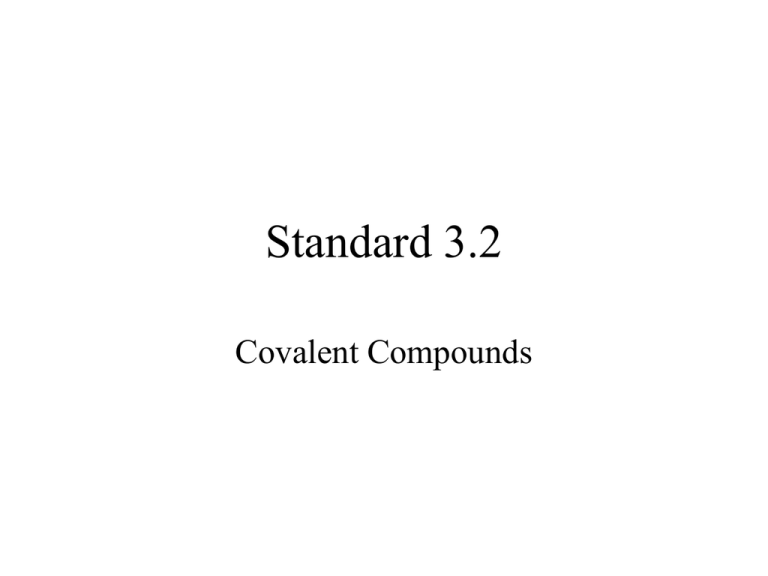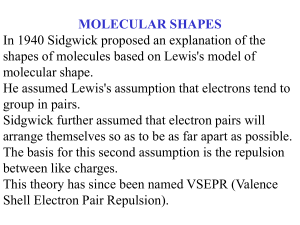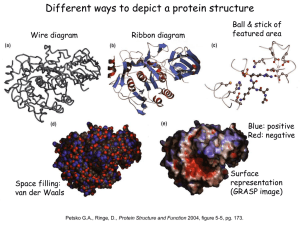Covalent compounds
advertisement

Standard 3.2 Covalent Compounds Everybody on the left side of the room will be an atom of sulfur. Everybody on the right side of the room will be fluorine. Please hold your element’s valence electrons in your hand. Everybody on the left side of the room will be an atom of sulfur. Everybody on the right side of the room will be fluorine. Please hold your element’s valence electrons in your hand. • Walk around the room and exchange electrons with your classmates in such a way that both you and your classmates end up being stable. Stay with your trading partner(s) when everyone in your trading group has become stable. Formation of covalent compounds • Covalent compounds form when nonmetals share electrons. Formation of covalent compounds • Covalent compounds form when nonmetals share electrons. • Because all nonmetals tend to gain valence electrons, the valence electrons must be shared to complete the octets. Formation of covalent compounds • Covalent compounds form when nonmetals share electrons. • Because all nonmetals tend to gain valence electrons, the valence electrons must be shared to complete the octets. • When electrons are shared between atoms, the bonds are relatively weak. Weak bonds mean… • Low melting and boiling points. Weak bonds mean… • Low melting and boiling points. • Generally gases at room temperature. Weak bonds mean… • Low melting and boiling points. • Generally gases at room temperature. • Some are liquids or solids. Weak bonds mean… • • • • Low melting and boiling points. Generally gases at room temperature. Some are liquids or solids. The solids have soft crystals. Weak bonds mean… • • • • • Low melting and boiling points. Generally gases at room temperature. Some are liquids or solids. The solids have soft crystals. Strong odor Weak bonds mean… • • • • • • Low melting and boiling points. Generally gases at room temperature. Some are liquids or solids. The solids have soft crystals. Strong odor Flammable Weak bonds mean… • • • • • • • Low melting and boiling points. Generally gases at room temperature. Some are liquids or solids. The solids have soft crystals. Strong odor Flammable Non-electrolytes Polar vs nonpolar covalent molecules • The smallest unit of a covalent compound is called a molecule. Polar vs nonpolar covalent molecules • The smallest unit of a covalent compound is called a molecule. • Molecules can be polar (a negative and positive region) or nonpolar. Polar vs nonpolar covalent molecules • The smallest unit of a covalent compound is called a molecule. • Molecules can be polar (a negative and positive region) or nonpolar. • The more polar a molecule, the stronger its bonds are. Polar vs nonpolar covalent molecules • The smallest unit of a covalent compound is called a molecule. • Molecules can be polar (a negative and positive region) or nonpolar. • The more polar a molecule, the stronger its bonds are. • Compounds with similar polarities will dissolve one another (“like dissolves like”) Determining Polarity • To determine whether a compound is polar or nonopolar, we need to first look at the difference in electronegativity between the atoms being bonded (table on p.265). Determining Polarity • To determine whether a compound is polar or nonopolar, we need to first look at the difference in electronegativity between the atoms being bonded (table on p.265). • If the difference is less than 0.40, the molecule is nonpolar (CH4 as an example). Determining Polarity • To determine whether a compound is polar or nonopolar, we need to first look at the difference in electronegativity between the atoms being bonded (table on p.265). • If the difference is less than 0.40, the molecule is nonpolar (CH4 as an example). • If the difference is greater than 0.40, a Lewis structure is needed (CO2). Drawing a Lewis structure • Begin by determining how many bonds the molecule contains. • • Number of bonds • Add the total number of valence electrons needed by the atoms in the molecule. Number of bonds • Add the total number of valence electrons needed by the atoms in the molecule. Example: CO2 Number of bonds • Add the total number of valence electrons needed by the atoms in the molecule. Example: CO2 carbon needs 4 electrons Number of bonds • Add the total number of valence electrons needed by the atoms in the molecule. Example: CO2 carbon needs 4 electrons each oxygen atom needs 2 electrons Number of bonds • Add the total number of valence electrons needed by the atoms in the molecule. Example: CO2 carbon needs 4 electrons each oxygen atom needs 2 electrons 4 + 2 + 2 = 8 valence electrons needed Number of bonds • Add the total number of valence electrons needed by the atoms in the molecule. Example: CO2 carbon needs 4 electrons each oxygen atom needs 2 4 + 2 + 2 = 8 valence electrons needed • Divide the total by 2 (8 / 2 = 4 bonds) Drawing a Lewis structure • Begin by determining how many bonds the molecule contains. • Connect the atoms with lines representing the bonds. Make it symmetrical if possible. • In this case, placing carbon in the middle with double bonds between the carbon and each oxygen makes it symmetrical. O=C=O Drawing a Lewis structure • Begin by determining how many bonds the molecule contains. • Connect the atoms with lines representing the bonds. Make it symmetrical if possible. • Finally, add any unshared valence electrons as pairs of dots. Oxygen: 6 valence electrons, two of which are shared, 4 unshared electrons. Oxygen: 6 valence electrons, two of which are shared, 4 unshared electrons. Carbon: 4 valence electrons, all of them are shared, 0 unshared electrons. Analyzing the structure • At least one of two things in a Lewis structure will make it polar… Analyzing the structure • At least one of two things in a Lewis structure will make it polar… 1) the molecule is not symmetrical Analyzing the structure • At least one of two things in a Lewis structure will make it polar… 1) the molecule is not symmetrical 2) unshared electrons on the central atom Analyzing the structure • At least one of two things in a Lewis structure will make it polar… 1) the molecule is not symmetrical 2) unshared electrons on the central atom • If neither of the above are true, the molecule is nonpolar. CO2 is nonpolar, because the molecule is symmetrical and there are no unshared electrons on the central atom. Is H2O polar or nonpolar? Is H2O polar or nonpolar? • First, we must check the difference in electronegativity between H and O. Is H2O polar or nonpolar? • First, we must check the difference in electronegativity between H and O. 3.44 – 2.20 = 1.24 (a Lewis structure will be needed) Is H2O polar or nonpolar? • First, we must check the difference in electronegativity between H and O. 3.44 – 2.20 = 1.24 (a Lewis structure will be needed) • Calculate the number of bonds. Is H2O polar or nonpolar? • First, we must check the difference in electronegativity between H and O. 3.44 – 2.20 = 1.24 (a Lewis structure will be needed) • Calculate the number of bonds. each H needs 1 electron, O needs 2 electrons 4 / 2 = 2 bonds Is H2O polar or nonpolar? • Try to draw a symmetrical molecule containing 2 bonds. H–O–H Is H2O polar or nonpolar? • Try to draw a symmetrical molecule containing 2 bonds. • Add dots for any unshared valence electrons. hydrogen, 1 valence electron, 1 shared electron oxygen, 6 valence electrons, 2 shared electrons Is H2O polar or nonpolar? Even though the molecule is symmetrical, there are unshared electrons on the central atom (O) making water a polar molecule. Is PF3 polar or nonpolar? Is PF3 polar or nonpolar? • Electronegativity difference of 1.79, a Lewis structure is needed. Is PF3 polar or nonpolar? • Electronegativity difference of 1.79, a Lewis structure is needed. • 3 bonds Is PF3 polar or nonpolar? • Electronegativity difference of 1.79, a Lewis structure is needed. • 3 bonds • 2 unshared electrons on P, 6 unshared electrons on each F. • Molecule is polar. Is AsH3 polar or nonpolar? Is AsH3 polar or nonpolar? • Electronegativity difference of 0.02, molecule is nonpolar. Is SO2 polar or nonpolar? Is SO2 polar or nonpolar? • Electronegativity difference is 0.86, a Lewis structure is needed. Is SO2 polar or nonpolar? • Electronegativity difference is 0.86, a Lewis structure is needed. • 3 bonds O–S=O Is SO2 polar or nonpolar? • Electronegativity difference is 0.86, a Lewis structure is needed. • 3 bonds O–S=O Is SO2 polar or nonpolar? • Electronegativity difference is 0.86, a Lewis structure is needed. • 3 bonds • add the unshared electrons O–S=O When two electrons are left unpaired, one of them must be moved. Is SO2 polar or nonpolar? • Electronegativity difference is 0.86, a Lewis structure is needed. • 3 bonds • add the unshared electrons O–S=O Always move the electron to the more electronegative element. Is PCl5 polar or nonpolar? Is PCl5 polar or nonpolar? • Electronegativity difference tells us a Lewis structure will be needed. Is PCl5 polar or nonpolar? • Electronegativity difference tells us a Lewis structure will be needed. • With a total of 8 electrons needed, we calculate 4 bonds are present, but 4 bonds are not enough. Is PCl5 polar or nonpolar? • Electronegativity difference tells us a Lewis structure will be needed. • With a total of 8 electrons needed, we calculate 4 bonds are present, but 4 bonds are not enough. • When this happens, you will only have single bonds and you use the minimum number of bonds possible (5 in this case). Structures such as this require an expanded octet, meaning the central atom ends up with more than 8 valence electrons. Unshared electrons are distributed just like in a regular Lewis structure. Unshared electrons are distributed just like in a regular Lewis structure. This molecule is nonpolar. Is BF3 polar or nonpolar? Is BF3 polar or nonpolar? • Electronegativity difference indicates that a Lewis structure is needed. Is BF3 polar or nonpolar? • Electronegativity difference indicates that a Lewis structure is needed. • With 8 electrons needed, 4 bonds should be needed. Is BF3 polar or nonpolar? • Electronegativity difference indicates that a Lewis structure is needed. • With 8 electrons needed, 4 bonds should be needed. Is BF3 polar or nonpolar? • Boron should be involved in all 4 bonds, but it only has 3 valence electrons to donate. Only 3 bonds can exist in this molecule. Is BF3 polar or nonpolar? • Molecules in which boron is the central atom will have an incomplete octet for the boron. Is BF3 polar or nonpolar? • Molecules in which boron is the central atom will have an incomplete octet for the boron. • This molecule is nonpolar.






